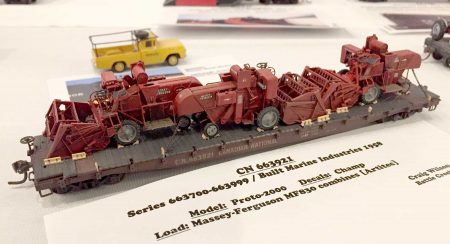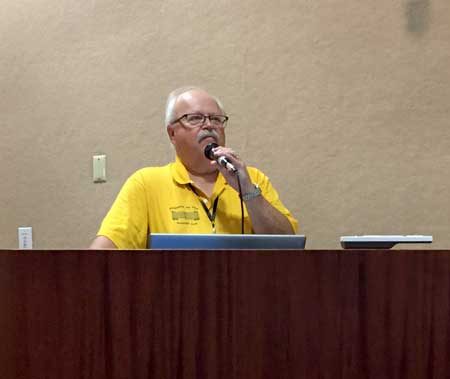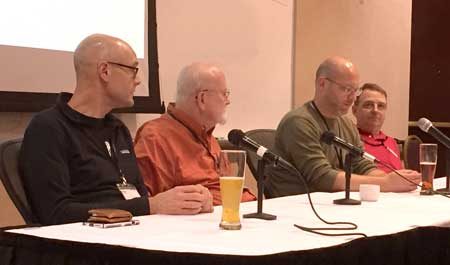
I’m recovering from a busy RPM Chicagoland weekend in Lisle, IL. The days seemed to blur right by like a speeding train. I took some notes to offer a summary. If you haven’t attended a railroad prototype modeler (RPM) meet, I encourage you to take action and attend a meet near you. The RPM event calendar is updated frequently with dates and links to these events around the country.

RPM Chicagoland celebrated 25 years of prototype modeling events. Martin Lofton founded meets in Chicago and California as a way to promote prototype modeling and his Sunshine Models resin kit line. Steve Hile did a great job after the banquet to commemorate modelers and companies who pushed prototype modeling forward over the years.

Steve held a Q & A with people involved with creating resin kit masters and casting components. There were many insightful thoughts on where the hobby has been and were resin kits are headed.

The presentations throughout the event were very good. I learned better soldering techniques and knowledge of soldering irons courtesy of Dick Harley and George Toman. Roger Hinman presented a thorough overview of New York Central steel flat cars. Quite a few were built before 1930 and I saw a couple of modeling opportunities. Bernie Kempinski wowed the group with an overview of his O scale United States Military Railroad and fascinating details on railroad operations during the Civil War. Kristin Dummler opened our eyes to the poultry car fleet development. I think most people who left her presentation felt they needed to add one or two of these specialty cars. Steve Hile shared his research on the Rock Island’s Decorah Branch and offered enough detail to sway a modeling focus. I presented a clinic on Pre-Depression Era Railroading, with a focus on the 1900-1930 years.
I heard several other clinics were top-notch, including XXtreme Modeler Bill Welch’s review of AAR and ARA steel boxcar design details, Craig Wilson’s techniques on producing real sky backdrops, and Hunter Hughson’s look at major industries. It’s hard to catch all of these and I missed a few presentations by falling into extensive conversations in the model display and vendor rooms.
I went to the event intent on snapping lots of candid photos but forgot as my mind became overloaded. Heck, I even forgot to snap photos of my own models on display! And so it goes. Here are links to galleries and other blog posts with thoughts on the event.
- Jeremy Dummler’s 2018 RPM Chicagoland gallery
- Eric Hansmann’s 2018 RPM Chicagoland gallery
- Ted Culotta’s blog
- Bernie Kempinski’s blog
I sat with Frank Hodina for a bit on Saturday afternoon and watched as the last of the Resin Car Works SFRD reefer kits were sold. We discussed upcoming kit releases and blog ideas. Frank hopes to have a new release soon with a couple more announcements after the first of the year.
I had a great time at RPM Chicagoland and that’s the real the bottom line. I thank Mike and Katie Skibbe, and their crew, for the tireless efforts in managing this beast. Also thanks to Harz for comic relief.
I’m already looking forward to 2019.
– Eric Hansmann – RCW web guy
The combines would have been made shortly after Massey-Harris merged with Ferguson (1953) by the 1970s they would be much more angular with full cabs, the model numbers seldom help with dating, usually being linked to size, weight, or capacity the same as construction equipment. Also riding on a flatcar like this they would be factory new with minimum weathering. Hope this helps.
Thanks for the info, Robert! – Eric
More information about those combines. They were made in France from 1958-1966 and sold in Europe. I have not seen any evidence that any were imported to North America. Those combines are also equipped with the bagging platform which was nearly impossible to find on North American combines in the late 1950s.
Robert is correct about the timeline of the merger and the looks of the combine designs.
Eric Thank You for the summary and links to other galleries which allow those of us not able to attend to share in experience attendees had.
I missed seeing you at the meet, Lester. – Eric
Eric
Excellent summary of the event. I will try to go next year.
Gene
Thanks Gene! Hope to meet you next year. – Eric
Really nice work. What is the era of the combined? Look heavily weathered.
Thanks for sharing.
RonS
I think the Massey Ferguson MF 830 prototypes began production in the early 1980s. I did a quick Google search so that date may not be correct. – Eric
The last two photos you have as “Unmarked” are models by Luke Lemmens.
Thanks Colin! I’ll make an update as soon as I can. – Eric